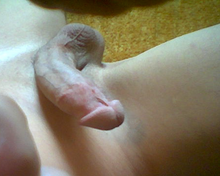Penis deviation
A penis deviation , also penis curvature (lat. Coles scoliosis) , is a deformation of the penis of various dimensions.
For most men, the penis is not straight. The flaccid or erect penis may naturally bend slightly. Curvatures of the penis beyond these natural variations can be congenital or acquired.
Congenital penile curvature
Congenital penile curvature is usually discovered in newborns. It occurs as a result of a genetic malformation of the penis. The curvature is caused, for example, by an asymmetrical development of the penile tissue, in which the erectile tissue is unequal in size or is shortened. Sometimes the urethra is shortened, known as hypospadias .
In contrast to the acquired penile curvature, the congenital penile curvature does not change in the adult man.
Acquired penile curvature
Acquired penile curvature occurs in 3 to about 7 percent of men, depending on the age of the man. Men with diabetes are more likely to be affected. The disease can develop slowly, with increasing kinking, or appear suddenly "overnight". The acquired curvature of the penis is also called induratio penis plastica (IPP). The onset of the disease is often accompanied by pain, especially during erection. The most common curve of the erect penis is an upward curvature. However, other manifestations, such as "hourglass-shaped" constrictions, are also possible.
The possible causes of the disease have not been conclusively clarified. There can be several completely different causes. Therefore, no causal treatment is currently available. The prevailing theory assumes that the smallest injuries to the penile tissue, so-called microtraumas, play an essential role in their development. The acquired curvature of the penis is treated with various drugs and treatment methods. Usually the goal is to relieve symptoms and prevent the disease from getting worse.
In the case of severe disease with severe kinks in the penis, however, surgery is sometimes the only option to help the patient to be able to have sexual intercourse again.
In some cases, however, the disease will improve on its own without treatment. However, there are no indications as to the factors on which this positive development of the disease depends.
treatment
In the case of congenital penile curvature, the attending physician must be advised as to whether or not correction by surgery is necessary. Since every operation is also associated with risks, an operation is usually only performed if the patient is suffering from pain or significant restrictions on sexual intercourse. Surgical correction for cosmetic reasons is generally not recommended.
There is unfortunately no causal therapy for acquired penile curvature (IPP) because of the unexplained causes. However, there are various treatment options available that can alleviate the symptoms or positively influence the course of the disease.
Conservative treatment options
All treatment methods that are not based on an operation are called “conservative”. This can be treatment with oral medication or with injections, in which the medication is injected directly into the penis. Various technical procedures such as iontophoresis or shock wave therapy are also used. Finally, there are also mechanical processes (vacuum pumps, stretchers) that are mentioned as forms of treatment.
The goal of conservative treatment is to relieve symptoms and stop the disease from getting worse. A cure in the sense of a complete regression of the penile curvature has not yet been achieved by any treatment method.
When the disease has moved into the stable phase, where the kinking of the penis no longer progresses and / or there are severe deformations, the only thing left is surgery to give the patient the opportunity to have sexual intercourse again.
Operative therapy options
The acquired curvature of the penis can only be operated on if the disease, e.g. B. has stabilized by drug treatment. Various surgical methods are used to straighten the penis. In the case of pronounced additional erectile dysfunction, a penile prosthesis can also be inserted during the operation to restore erectile function.
The aim of the operation is not to restore the "original state" before the disease, but to enable the patient to have sexual intercourse again. Depending on the surgical method, shortening of the penis or loss of sensitivity may have to be expected.
The procedures include the Nesbit surgical method (first described in 1965) and the Schröder-Essed shirring (described 1985). From 1996 to 2001, 82 operated patients at the urological clinic of Klinikum Dortmund gGmbH were examined with regard to the effects of the operations.
Individual evidence
- ↑ U. Schwarzer, F. Sommer, T. Klotz, M. Braun, B. Reifenrath, U. Engelmann: The prevalence of Peyronie's disease: results of a large survey. In: BJU International . Volume 88, 2001, pp. 727-730.
- ↑ A. Tefekli, E. Kandirali, B. Erol, M. Tunc, A. Kadioglu: Peyronie's disease: a silent consequence of diabetes mellitus. In: Asian Journal of Andrology. Volume 8, 2006, pp. 75-79.
- ↑ A. Hauptmann, T. Diemer, W. Weidner: Induratio penis plastic (IPP). In: Diagnostics and Therapy, Urologist. Volume 50, 2011, pp. 609-620.
- ↑ RM Nesbit: Congenitale curvature of the phallus: Report of three cases with description of corrective operation. In: J Urol. 1965, 93, pp. 230-232
- ↑ E. Essed, FH Schroeder: New surgical treatment for Peyronie's disease. In: Urology. 25 (1985), No. 6, pp. 582-587.
- ↑ www-brs.ub.ruhr-uni-bochum.de
literature
- D. Ralph, N. Gonzales-Cadavid, V. Mirone, S. Perovic, M. Sohn, M. Usta, L. Levine: The management of Peyronie's disease: Evidence-based 2010 guidelines. In: The Journal of Sexual Medicine . 2010, pp. 2359-2374.
- A. Hauptmann, T. Diemer, W. Weidner: Induratio penis plastic (IPP). Diagnostics and therapy. In: Urologist. Volume 50, 2011, pp. 609-620.
- Theodor Klotz, Michael J. Mathers, Frank Sommer: Induratio penis plastica - a secret disease. In: Deutsches Ärzteblatt. Volume 104, 2007, pp. 263-267.

